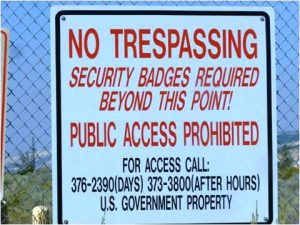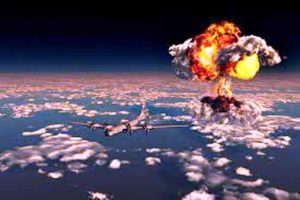Toxins in Our Environment: A Firsthand Account
Emma Ollerhead
The pollutants in our ecosystem have been the topic of conversation for decades, with the concern only growing as the impact nears becoming irreversible. There are countless examples of chemicals that have been used in everyday products that we later learn are leaking dangerous toxins into the water and food sources communities rely on. For my grandfather growing up, his concern was with having radiation exposure, as his family lived near the reactors that produced the plutonium that was used in the atomic bomb dropped on Nagasaki in 1945. I decided to ask my grandfather, Jack, if he would provide a few photographs he has taken over the years relating to the Manhattan Project along with some insight into what they mean to him.

“I took this picture of the sign that was on one of the fences surrounding the reactors at Hanford. It illustrates for me the enormous danger and secrecy behind the creation of the bomb produced by the Manhattan Project. My father had a “top security clearance” that enabled him to enter this top secret area in 1948. I recall, at 6 years old, going with my mother to pick up my father for lunch. We would wait for my father outside the guarded gate and fences that had signage similar to this one.”
My great-grandfather, Jack’s father, was employed by the chemical manufacturing company DuPont as an Inspection Engineer. This is the company that was employed by the U.S. government to produce the plutonium used in the atomic bomb. In 1947, Jack and his family moved to Richland, Washington because his dad was going to be working at the Hanford site. There were thousands of people employed under DuPont who worked on the Manhattan project and had no idea what they were truly working on. They would walk around the factory with blocks of plutonium in their pockets, having no idea how dangerous it really was.

“This was the area created from the desert by the government to house the construction and operation personnel at Hanford, creating the city of Richland, Washington. For three years after the war, we lived in one of the very small ‘cookie-cutter’ houses built for the Engineers and Management. The reactors nearby produced enormous discharges of radioactive material into the atmosphere and the Colorado River. The fallout fell downwind on the farms in the area where we lived. People who were downwind, and ate farm products and the fish from the river, therefore, had various degrees of radiation exposure. Some of the exposure came from the milk produced by the cows that ate the grass in the contaminated fields. This was my concern when I learned from my mother that we used to buy unpasteurized, non-homogenized fresh milk directly from the local farmer. We also used to go out to an abandoned farm that was downwind, and hand-picked the tips of asparagus.”
The radioactive clouds produced by the reactors left a devastating impact on both the environment and the people who lived close-by. The harmful effects of the radiation surpassed solely the employees of DuPont and left many people with radiation sickness. The chemical waste contaminated the land in the surrounding areas, and thousands of people unknowingly consumed crops and water tainted by radiation. This leaves an enormous question as to if the government knew how harmful the chemicals truly were and if something like this could happen today.

“This picture reminds me of the unbelievable tremendous power and destruction that the atomic bomb had when dropped over Nagasaki on August 9, 1945. Although just as destructive as the first bomb dropped over Hiroshima a week earlier, this bomb was produced by plutonium. My father worked at 8 locations that produced the radioactive material for the reactor at Hanford, which then produced the plutonium. He had lived most of his life with radiation sickness, having been exposed to U235 while working on the Manhattan Project. He died at the early age of 66 with esophageal cancer, brought on by the radiation exposure.”
After the atomic bomb was dropped, the employees of DuPont began to put the pieces together of what they had been working on for so many months. Seeing the destruction it caused to Nagasaki, they began to worry about what side effects they may have from being around chemicals for such long periods of time. Because the radiation exposure was so under researched at the time, almost everyone who worked on the Manhattan project wound up with radiation sickness that potentially turned fatal. I never got to meet my great-grandfather because of how young he passed away, but always heard stories of him being a part of producing the atomic bomb. Today, we know a lot more about the harmful effects of radiation and have taken precautions to ensure exposure is limited. Regardless of this, there is still potential to be exposed to cancer-causing chemicals in everyday life.
THEME
While the topic of radiation in the 1940’s may not seem relevant today, it is an important conversation that needs to be had about what we may be exposed to unknowingly. There are harmful chemicals, such as per- and polyfluoroalkyl substances, or PFAS, that are long-lasting in both the environment and our bodies. These chemicals are found in hundreds of household products, such as shampoo, nail polish, non-stick cookware, cleaning products, and so much more. Because this chemical breaks down so slowly, it is found in “water, air, and soil at locations across the nation and the globe” (EPA website). Similar to how there was not much known about radiation exposure in the mid 1900’s, there is still a lot not understood about these chemicals today. Their impact on the environment is clearly destructive and solutions need to be found as to how to break them down more quickly, or eliminate them completely.
Linking this to a bigger theme, humans have done so much harm to the environment in the 200,000 years we have existed. The “Perspectives of Nature” video found in module 2 is a powerful testament to how much damage we have caused in such a small amount of time. Relating how long humans have been on Earth to how long Earth has been in existence, the creator of the video compared it to a single day. If the Earth was one 24 hour day, humans would have existed for just 3 seconds of those 24 hours. That is roughly 0.003% of Earth’s existence. To quote the creator, “the real crisis is not global warming, environmental destruction, or animal agriculture. It is us. These problems are symptoms of us.”
There needs to be a real change in regulations and what chemicals should be allowed. The government was able to so easily deceive thousands of employees to work on an atomic bomb without knowing it. The real question is if this could be happening today. I don’t want my grandkids to look back at my life in 70 years and talk about how I should’ve avoided certain cancer-causing things we aren’t aware of today. We need to bring awareness to the harmful chemicals so quickly placed in our foods and our household items. We need to bring awareness to the impact the environment is seeing from these chemicals. We need to be the change, so our grandkids don’t have to live in a world tainted by the mistakes we made.
SOURCES:
Environmental Protection Agency. (n.d.). PFAS Explained . EPA. https://www.epa.gov/pfas/pfas-explained
YouTube. (2015, November 24). Man vs earth (2023). YouTube. https://www.youtube.com/watch?v=VrzbRZn5Ed4&t=222s
Media Attributions
- No Trespassing Sign
- Construction Camp
- Atomic Bomb over Nagasacki

